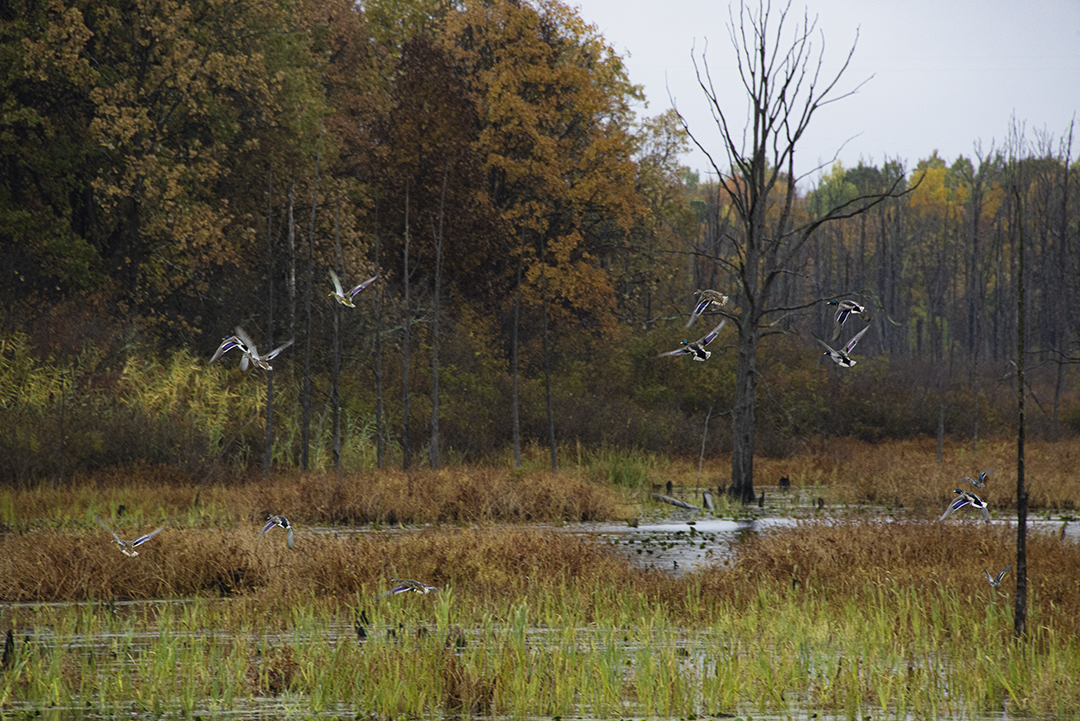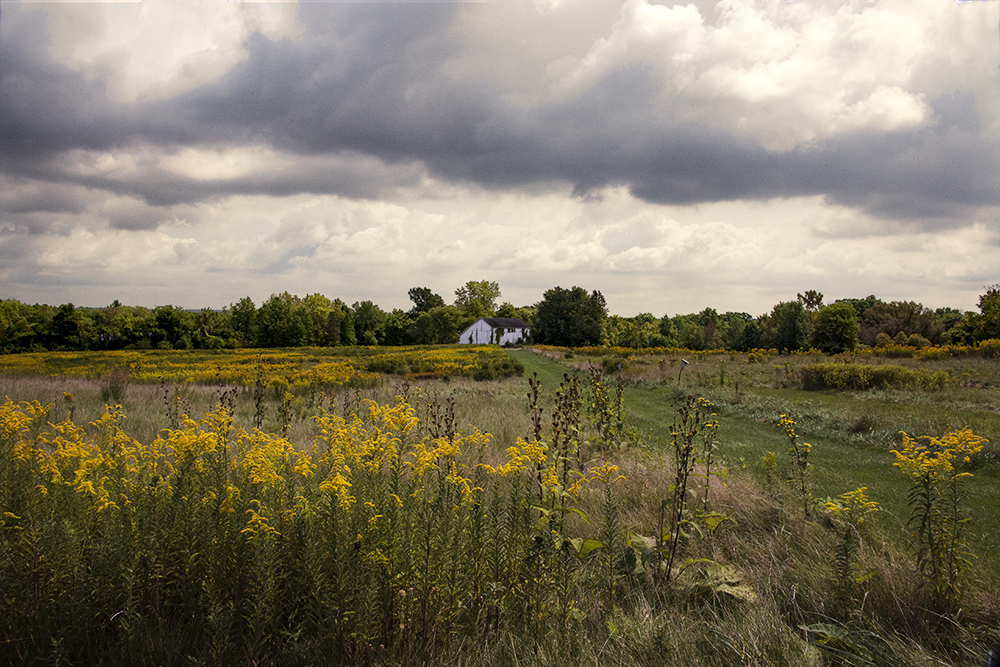
“Autumn Grass, Hudson River Valley”

“Autumn Grass, Hudson River Valley”


“Late to Flush Mallards”
This morning (Wednesday, Oct. 19) provided for an unanticipated closeup as migrating mallards, after holding tight through freezing rain and the season’s first trace of snow, burst into flight at the west end of the marsh . In deeper water, 100 yards to the east a pair of redheads and a raft of lesser scaups, more backsides visible than heads, were tipping and resurfacing like “drinking bird toys”, as they foraged below.

Goldenrod, September’s Child
“Requiem ”
“Tuft of Flowers”
“ …
But he turned first, and led my eye to look
At a tall tuft of flowers beside a brook,
A leaping tongue of bloom the scythe had spared
Beside a reedy brook the scythe had bared.
I left my place to know them by their name,
Finding them butterfly weed when I came.
The mower in the dew had loved them thus,
By leaving them to flourish, not for us,
Nor yet to draw one thought of ours to him.
But from sheer morning gladness at the brim. … ”
Robert Frost
Written in 1915, Frost’s poem reflects nostalgic values of an earlier era, ones I fear we’ve lost through the century that’s followed. The speaker here, tossing just cut grass to dry in the morning sun is led by a butterfly to a tuft of flowers spared by one who had mowed earlier that morning. A small expression of humanity had left the flowers intact, presumably for their sheer joy and by the simple grace of the mower. Considered today in the context of the political divide roiling our Republic and the unprecedented normalizing of lies and conspiracies, Frost’s poem, quaint even in its time, is nonetheless an aspirational metaphor for the present era. “Return to Nature!”, the familiar rallying cry for many of us disaffected by contemporary society, has become a routine anodyne to our predicament, its healing qualities now foundering in cynicism and despair. Although I too have invoked the ameliorative power of nature, an experience this past week has shaken my confidence even in the natural world to salve and bridge the divide. To that point, posted below is a series of photographs accompanied by further context and a brief story to document the event.
I can’t recall precisely but I believe I was nine or ten, some 65 years ago, when I first walked these rural northbound tracks of the Wheeling & Lake Erie Railway running from Canton and Brewster, through Aurora and on to Cleveland. Even then many of the trees were interlaced high above the tracks that cross Old Mill Road in Aurora continuing on north to feed Lake Erie’s freighters.
The trees, forming a short tunnel beneath their canopy, became my “gateway” to the marsh, to its inner woodlands and to a small cloistered meadow at the east end. I always had the feeling something mysterious lay beyond their long shadows, something numinous yet benign and familiar waiting to be explored. And it was through exploring this “other” world I learned lessons of the woods and wetlands and, over a lifetime, discovery of myself as well. Identifying trees, for instance, how leaf lobes distinguish oaks (white, red and pin); how to recognize the smooth bark of immature beech thriving beneath the canopy as they hold their translucent, parchment leaves through winter; remembering elm and ash now lost; spotting scattered sugar and rock maple here and there, and finding the increasingly rare wild black cherry trees.
The cherry (arched in the first three images below), content with time’s slow passage, etched its shape through space over decades. Years earlier the tree underwent a slow transformative process known as inosculation, its trunk grafting naturally with another cherry that resided in a small copse. One trunk grew vertically, the other cantilevered over the track its bough arched high above passing trains. Here the story begins.
Last week I returned to the marsh, walking the rails as I do every week, savoring the flashes of wildlife and the sounds and earthy fragrances that have marked generations of this undisturbed land. As Frost’s tuft of flowers was metaphoric, so too would become the sight that lay ahead.
Lying before me a startling assault on the landscape; indescribable, indiscriminate and likely an unceremonious destruction of trees that had lined the tracks. A rail crew assisted by modern technology had butchered trees on either side of the rails, and along with these living creatures, the beauty and innocence of place – a sacred aesthetic element of the landscape as well as a home and food source for wildlife. The 4th, 5th and 6th images below depict the slaughter. The history of this land, silent through the slow passage of time, transmuted in a moment. The ancient cherry reaching over the tracks was chewed to a shell, its branches only stubs, the ultimate indignity a remnant of its eviscerated trunk. I would also note, the carnage had extended twice as far as the prescribed 15’ clearance for freight trains.
By happenstance several days later I witnessed the probable instrument of destruction near a rail crossing in Solon. A brush cutter known as a Kershaw Klearway 500 ( https://www.youtube.com/watch?v=gvAGPDtl_qg) mounted on rails, its rotary cutter-head mangling trees and brush, sating the hunger of its operators. This giant brush cutter projecting outward on a boom about 25 feet, was shredding vegetation along the railway. Masticating large trees and boughs within its ravenous maw, reminding me of an AK 47’s capacity to gratify the exigent machismo of some men. Humanity’s hubris will never be lost so long as the pernicious combination of technology and man’s desire for dominion over nature continues. And so, short of eye-witnessing the destruction at the marsh, I deduced it was probably the same or a similar machine that had ravaged the old cherry and untold other trees along the edge of the marsh.
As I began to inspect the area, the keening cry of a red-tail hawk (Image No. 7), followed me, circling for the next 10 or 15 minutes until I returned to my car, its plaintiff, high-pitched cry a requiem; its own lament, casting grief upon the wind, over the woods where it fell upon the marsh – history and pathos buried beneath grass and sedge. His nest, at the top of a mature beech, also had been destroyed by the rail crew. I wondered if he recognized me as I’m probably the only one he regularly encounters. I took his declarations as a coda in the aftermath.
What significance can we ascribe to a relatively trivial event when the world is on fire, almost literally as it appears in this moment? The recent and accelerating divisions that afflict our society, the geopolitical struggles and the existential exigencies that threaten the planet have another origin it would seem to me. Jung would point to the shadows.

No. 1 Summer Rails

No. 2 Autumn Rails

No. 3 November Rails

No. 4 First View

No. 5 Laid to Waste

No. 6 Death of an Ancient Wild Cherry

No. 7: Red Tail’s Requiem

Standing beneath these trees when the wind blows one hears the squeak and groan of trunks and boughs and the sibilant rustling of leaves. This particular stand of black willows has mesmerized me for five decades, like a giant metronome dancing through space, its crowns moving in unison to a light breeze; its black bark, interlaced and deeply furrowed providing contrast to the delicate yellow-green leaves of early spring. But also, I’ve admired the restive side of their personality, when the trees beat and flail against strong winds sweeping down the farm’s western slope and, for all their frailty, holding, indefatigable, resolute, never breaking. Above the waterline, the massive root system, now fully integrated into sand and loam, provides ballast to secure the trees and bank. And, completing the aesthetic, an inner ring of cattails frames this frequently overlooked landscape.

“End of Winter, Rushes and Purple Stemmed Aster”
Favorite lines I return to at the end of each season are from Robert Frost’s “Reluctance”, concluding with the final stanza, “Ah, when to the heart of man was it ever less than a treason to go with the drift of things … and bow and accept the end of a love or a season.”
This photograph is my version of a winter meadow; purple-stemmed asters and bulrushes, absent color, angulated against the snow create a composition all their own, still gentle, still determined, casting the subtle shadows of mid afternoon. Crossing the ice I thought this was the last image of snow for the season, a day before a thaw would cut off access to the north end of the marsh until next winter. Late that afternoon, the lip of the bank was barely discernible as its faint shadow traced the shoreline of a small cove (a bight the British might say). The frozen waters, little more than crystal shards, were punctuated with mineral mounds of wetland soil where outcrops of sedge and rush and long deceased pin oaks still stand, all rising above the ice awaiting the new season.
Designed by Elegant Themes | Powered by WordPress